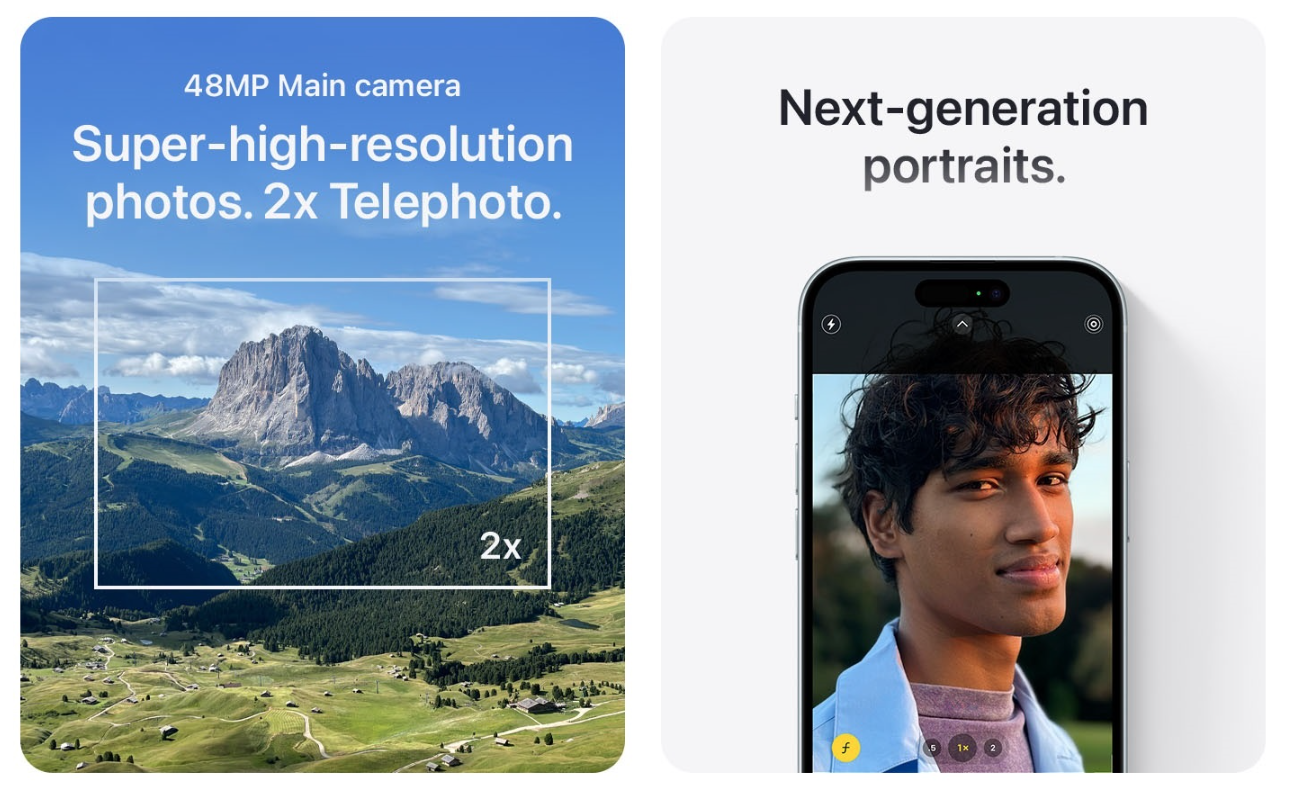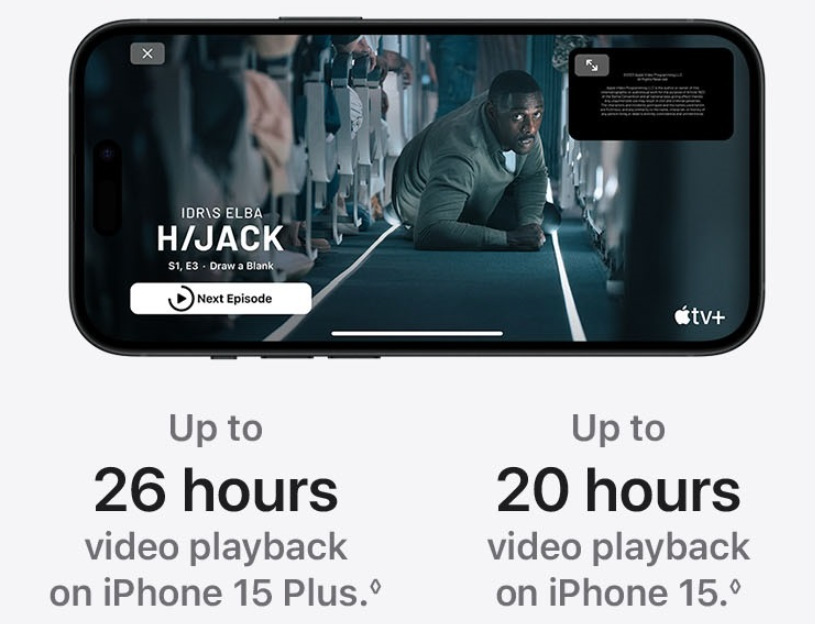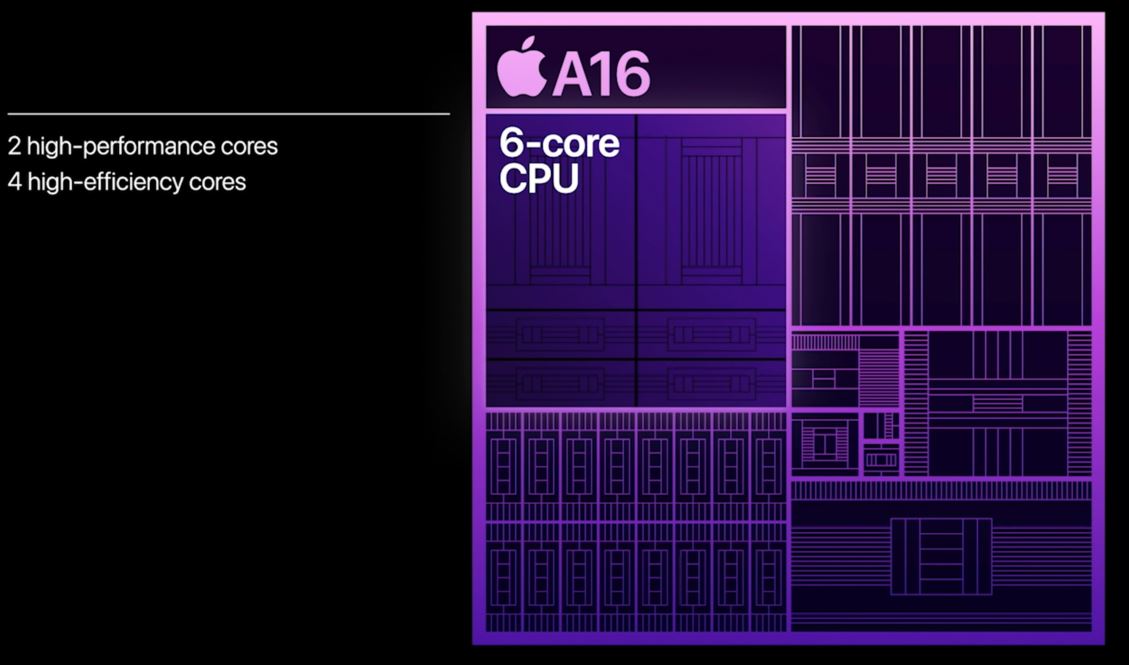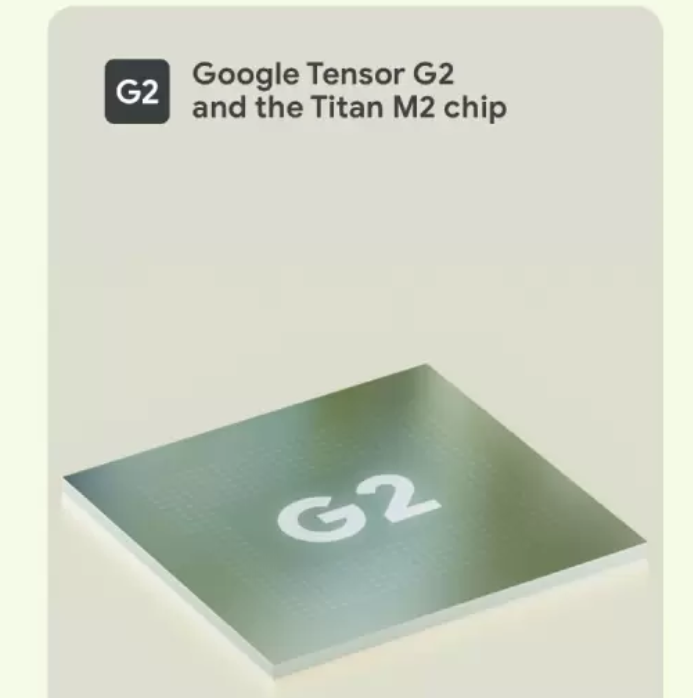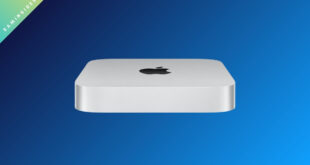The iPhone 15 was announced at the Wonderlust event on 12th September, alongside the Pro series and the Apple Watches. If we compare the differences between the iPhone 13 and the iPhone 14 to the differences between the iPhone 14 and the 15, the latter is a much more significant upgrade overall.
Between the 13 and 14, we got a minor GPU bump from the 4-core GPU A15 to the 5-core GPU A15, a slightly larger primary sensor, and a new front camera with autofocus. It didn’t get any of the extras from the Pro models.
This year, the iPhone 15 gets plenty of new changes. Display brightness was a key complaint with the iPhone 13 and 14. The iPhone 15 fixes that since it offers a display that reaches a whopping 2000 Nits in peak HDR brightness. We shouldn’t take peak brightness values too seriously since they only correspond to particular areas that display highlights on your screen when playing HDR content.
Another major upgrade to the iPhone 15 is a new 48MP sensor. It’s large enough to enable 2X in-sensor crop for near-lossless optical zoom. This also allows you to take portraits at 48mm, and you couldn’t do this before. The iPhone 15 also gets the 4nm A16 Bionic SOC from last year, but there isn’t any notable improvement in overall performance since the display still refreshes at 60Hz.
The Pixel 7 is one year old, and we already have a good general idea of its performance. The 90Hz 1080P display flies through the UI and maintains stable software with regular monthly security updates. Cameras remain a key selling point for the Pixel 7. This article will compare these two phones on paper, attempt to pick a theoretical between the two, and hopefully assist with your purchase decision.
Apple iPhone 15 vs Google Pixel 7 Comparison
1. Display & Multimedia
The Pixel 7 ships with a 90Hz 1080P AMOLED (416 PPI) screen and a maximum brightness of 1000 Nits in High Brightness Mode. It can reach 1400 Nits when playing HDR content. The phone also supports the HDR10+ standard, and it’s relatively compact at 6.3″ in contrast to most of today’s phones.
The color calibration isn’t anything exceptional. It doesn’t emulate the 10-bit color depth as well as the iPhone using dithering. It also doesn’t support the Dolby Vision HDR Standard, which the iPhone does.
We don’t yet have information on the PWM frequency of the iPhone 15. It isn’t easy to gauge the iPhone 15’s PWM. For the iPhone 14, sources claim that it’s 60Hz, but the exact source mentions that it’s the same as the iPhone 13. However, the iPhone 13’s display PWM was 610Hz, not 60Hz. We thankfully have a consistent number for the Pixel 7, and it’s 360Hz.
Note that the PWM area requires more study. Some people are sensitive to inconsistent PWM rather than low PWM, and PWM varies considerably between brightness levels. It’s safe to assume that these two phones aren’t champions in eye comfort if you’re sensitive to low or inconsistent PWM.
The iPhone 15 refreshes at a disappointingly low 60Hz but has a much higher peak brightness of 2000 Nits during HDR. It also hits 1600 Nits of brightness outdoors; both figures are higher than the Pixel. These numbers aren’t reliable since brightness perception is logarithmic. The screen only reaches these numbers in specific areas when playing HDR content.
The iPhone 15 has a sharper display at 461P and a weird 1179P resolution. Both are sharp enough that you won’t discern individual pixels, but text could appear sharper on the iPhone to those who notice. Overall, the iPhone has a better display for content consumption, and the refresh rate doesn’t add anything to the multimedia experience.
You might still pick the Pixel just for the refresh rate, but the iPhone offers a better content consumption experience. The Pixel 7 didn’t have great speakers either, while the iPhone is one of the industry standards for this.
Winner: iPhone 15
2. Cameras
The Pixel 7 has a much larger primary sensor, giving it a direct head-start in the hardware department. The iPhone’s isn’t a tiny sensor, coming in at 1/1.53″ and a 48MP resolution. The Pixel has a 50MP resolution, but the GN1 sensor is 1/1.31″ in size.
Historically, the Pixel has much image processing. Since the Pixel has better hardware, we don’t expect the iPhone to catch up with the Pixel in photography. It’s difficult for any Android to beat the iPhone’s videography. It’s worth mentioning that the Pixel has a lot more features here. You can lock focus and take Cinematic Pan videos; plenty of stabilization options exist. The iPhone can’t switch lenses in 4K60 FPS recording mode, but the Pixel can do that.
The iPhone still beats the Pixel 7 at video recording. It can shoot super-stable videos with Action Mode at a much higher 2.8K resolution, and the Pixel can only 1080P. The iPhone also has Cinematic Videos at 4K 30FPS with HDR, while the Pixel lacks this, too. Dolby Vision HDR video recording remains a major advantage with video on the iPhone.
The Pixel’s photos aren’t free of flaws since they have issues with red skin tone and occasional over-processing. This makes the Dynamic Range in photos look too artificial at times. However, it still surpasses the iPhone’s HDR for now and has much more accurate skin tones.
Since the primary sensor is much larger, the low-light output of the Pixel should surpass the iPhone. Google is known for its prowess with its low-light algorithm, Night Sight. Apple doesn’t process the image as much, leaving plenty of shadows dark, and images occasionally appear noisy with poor highlight control. Apple’s issues also extend to poor lens flare management, which, according to initial reviews, isn’t any better in low light despite the new lens coating.
The new Smart HDR 5 standard is much better at controlling harsh backlights. However, it’s not a dynamic range champion like the Pixel is. Neither of the phones offers the best front camera performance. Both oversharpen to compensate for the lack of organic detail, and the sensors aren’t very large either.
Zoom and Portraits
According to the advertisements, both phones offer 2X zoom in “lossless” quality. However, this isn’t true optical zoom. It doesn’t have the optics for 50mm, but it uses the primary sensor instead. You still get a full 12MP/ 12.5MP output, but it doesn’t have the same facial features, lens compression, and bokeh dropoff of a true zoom lens.
While the 2X crop remains serviceable to the average consumer, it’s misleading to market this as optical zoom. Both Apple and Google are guilty of this. On the bright side, the Pixel 7 and iPhone 15 can take portrait mode photos at 2X zoom.
Sensor crop uses the middle of the large sensor, so the result is still better than digital zoom. The Pixel 7 nails skin tones and dynamic range with portraits, but the iPhone typically has a more natural bokeh dropoff, and it’s better with edge detection. The Pixel processes human skin too much in portrait mode and looks rather wonky. Over-sharpening is visible, and the algorithm isn’t as good as the iPhone.
Winner: Pixel 7 for photos and iPhone 15 for videos
3. Battery & Charging
The iPhone 15 is under 3500 mAh of battery capacity, and the Pixel 7 has a 4355 mAh battery. However, the Pixel’s display doesn’t use materials as efficient as the iPhone 15. It also refreshes at 90Hz, and that drains more battery.
The Pixel 7 uses the Google Tensor G2 SOC but isn’t as efficient as the A16 Bionic. Apple’s 4nm A16 can output more power while delivering better performance per watt. The G2, with 5nm Samsung fabrication, can’t keep up with that. This pretty much offsets the difference in battery capacities.
Effectively, battery life should come down to a draw between these two phones. The Pixel has a larger physical battery, and Pixel’s UI is very light and efficient. However, iOS is extremely efficient with power and even suspends several background processes to manage the battery better. The A16 Bionic chip negates the difference in battery capacity, and both should offer around 7 hours of screen time with mixed to moderate usage. If your use case is very heavy and involves gaming, expect a dip to under 5 hours of screen time.
Both phones are extremely unambitious with charging speeds. Both use sub-standard charging speeds in an age where phones charge at 80W, 100W, and more. The Pixel 7 charges at 20W, and the iPhone 15 also charges at 20W- barely enough for half the charge in half an hour. The iPhone’s physical battery is smaller in capacity, so it’ll also degrade faster over time. The Pixel will maintain more of its charge over two years, while the iPhone could drop below 80% in battery health.
The Pixel also benefits from monthly updates, which do contain battery improvements. With iOS updates, your screen time is a hit-or-miss most of the time. Some updates worsen the standby drain and drastically reduce your battery life.
Winner: Pixel 7
4. Performance
The iPhone 15 runs Apple’s A16 Bionic SOC from last year. The Tensor G2 from the Pixel 7 uses rather old internals, and the CPU cluster doesn’t even come close to the A16 Bionic. The A16 Bionic has two performance cores at 3.46 GHz and four efficiency cores at 2.02 GHz. The efficiency cores are as good, if not better than Qualcomm’s mid-tier cores on the latest 8 Gen 2. That’s very impressive, and the A16 Bionic (TSMC 4nm) completely beats Google’s Tensor G2 (Samsung 5nm).
It uses TSMC’s N4P processing, which isn’t true 4nm, but a pseudo-4nm processor, which is still impressively efficient. TSMC pseudo-4nm SOC is still leagues ahead of Samsung’s inefficient 5nm fabrication. With 6GB of LPDDR5 RAM, the A16 is a great chip for gaming, especially considering that developers optimize games for iOS better than Android. This is because Apple makes fewer models, but they sell in vast amounts.
The A16’s ISP can perform complex calculations like real-time edge detection for cinematic videos in 4K at 30FPS. It also supports stabilized 2.8K videos in Action Mode. According to previous tests, the A16 can maintain a consistent 59.1 FPS in Genshin Impact for 30 minutes, and it’s incredibly efficient while doing so.
Genshin Impact is a very performance-heavy game that stresses out the CPU, and it’s typically hard to handle for smartphones. As expected, the Pixel’s outdated cores can’t keep up with this, and it struggles to run the game at even 40 FPS consistently. Moreover, there are plenty of reports about the Pixel 7 draining the battery severely. The phone’s signal reception and 5G speeds aren’t as good as the iPhone.
The Tensor G2 has two Cortex-A1 cores, two A-78 cores, and four efficiency Cortex-A55 cores. This isn’t as good as the A16 Bionic, and it scores about 1500 in the single-core Geekbench 6 test and 3700 in the multi-core Geekbench 6 run. That’s not even close to the 2600 single-core score and the 6900 multi-core score of the A16 Bionic on the same benchmark. The Pixel 7 Pro scores about 66% in 3D Mark Wildlife stability, almost the same as the iPhone 14 Pro (and presumably the iPhone 15).
However, the Pixel’s max loop score is still lower than the iPhone’s lowest loop score, making the iPhone the clear winner in the performance department, especially for gamers and heavy users. The iPhone has better CPU and GPU performance, the efficiency and stability are better, and it won’t heat up as much despite lacking a cooling system.
Winner: iPhone 15
Hardware Specifications Table
| iPhone 15 | Google Pixel 7 | |
| Display | 60Hz 1300P OLED, 2000 Nits Peak Brightness (Dolby Vision HDR, 10-bit Dithering) | 90Hz 1080P OLED, 1400 Nits Peak Brightness (HDR10+ and 8-bit) |
| Battery | 3300 mAH Approx | 4450 mAh |
| Cameras | Dual, 48MP 1/1.55″ primary+ 12MP ultrawide, 2X lossless sensor-crop zoom
12MP front camera |
Dual, 50MP GN1 1/1.31″ primary+ 12MP ultrawide, 2X lossless sensor-crop zoom
10.8MP front camera |
| Chipset & Software | Apple A16 Bionic (TSMC 4nm)
iOS 17 (Guaranteed five years of major updates, up to iOS 22) |
Google Tensor G2 (Samsung 5nm)
Android 13 (Guaranteed three years of major updates, up to Android 16) |
| Charging | 20W wired charging via USBC (2.0), 15W wireless charging (MagSafe), 7.5W Qi | 20W wired charging via USBC (3.2), 20W wireless charging, ~5W reverse wireless charging |
5. Software
The Pixel runs Android 13 out of the box and will get consistent monthly updates. It’s promised three years of major Android updates, which will take it to Android 16. The iPhone is newer, so it ships with the latest iOS 17 out of the box and will get updates till at least iOS 22. Apple could give it more updates if the hardware supports it.
We can’t pick a winner in the software updates department. The Pixel has excellent community support, and you can update it well beyond its time. We also can’t compare iOS updates to Android updates since Google releases major updates through Google Play Services too. There’s no such thing on iOS, and several apps will stop working two years after the update tenure ends. It’s not the case with Google, and apps will continue to work fine well after the major software updates end.
We also can’t pick a winner between iOS and Android for obvious reasons. If you’re in the Apple ecosystem and already have a MacBook or an iPad and AirPods or the Apple Watch or a combination of these, the iPhone makes much more sense.
Suppose your area is heavily reliant on iMessage and FaceTime. In that case, the iPhone is the only choice to stay in contact properly, which is Apple’s fault, considering they don’t support RCS Messaging yet. If you don’t mind trying out new software, then the Pixel will feel a lot more refreshing if you were on iOS for years.
iOS has its perks, like shared Focus Modes, elegance and smoothness of the software experience, better Lock Screen customization, Scheduled Summary, privacy features like Hide My Mail, and more. Google has its own AI perks, and Android is the enthusiast choice for overall customization and tinkering.
Winner: Personal Preference
6. Design
The Pixel 7 has some durability concerns with the rear glass and is very prone to scratches. Several reviewers recommend using tough cases to protect it since the build quality isn’t very durable. It’s still premium to hold, and the design is a bold look. It has a camera visor at the back, a horizontal camera module, and a blocky overall design.
The camera visor solves the camera wobble issue, which all iPhones still have. This is annoying on a table without a case. It has the IP68 water resistance rating, and the Google logo is placed in the middle.
The iPhone 15 has a generic iPhone design with a diagonal array of dual cameras at the top left. It now has a frosted matte finish on the rear instead of glossy from last year. The aluminum rails and back are now slightly curved, and the phone fits in your hand much better than before.
The notch is also replaced by the Dynamic Island, which was on last year’s Pro models. The Dynamic Island still interferes with content consumption, and many dislike the design. This section is up to personal preference since design is one of the most subjective aspects of a phone.
Winner: Personal Preference
Conclusion & Pricing
In the USA, the Pixel 7 costs $599 and drops to as low as $499 during festive seasons and offers. That’s an excellent price for the hardware package, and it one-ups the much more expensive $799 iPhone 15 in several categories, too.
The iPhone 15 wins a lot of important categories in this comparison. It has a better chip and doesn’t have cellular reception issues, which is a core smartphone basic. The Pixel fails to maintain consistent performance and is unreliable with temperature control. The only thing that stops the iPhone from being an objective winner is the $200 extra price, and a 60Hz display at that price cannot be justified despite the other advantages.
If software doesn’t matter to you and you’re fine with using iOS or Android, then the comparison is still a draw. The iPhone takes performance display brightness and video quality, but the Pixel takes photography, price to performance, screen refresh rate, AI features, and more.
It depends on what you want from your phone. If you want great gaming performance or if you shoot a lot of videos, the iPhone is the better choice. The Pixel is undeniably better for photography and a faster software experience with that 90Hz refresh rate, considering you can also get it for much cheaper than the iPhone 15.
Winner: Inconclusive

